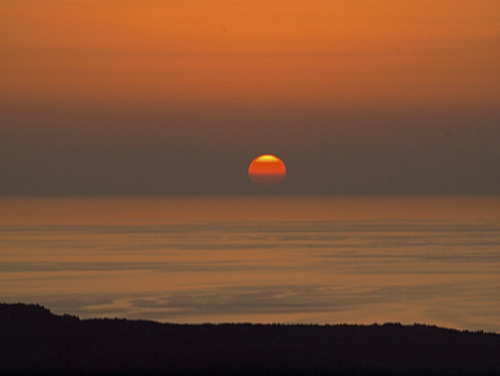On February 26, 2019, Edmund K. Parowski of Williams, Arizona, photographed a stunning sunset from the volcanic island of Santorini (Figure 1). This view from Fira on the eastern wall of the collapsed caldera overlooks Nea Kameni (Greek for “new volcano,” in reference to the caldera’s still-emerging central island) and the Aegean Sea beyond. The image captures the feel of the sunsets that have inspired poets for ages. But there is more to the image than meets the eye.
Particularly, note the two Suns. As Parowski wrote, “I haven’t seen anything quite like this before. It seems as if both Sun images are casting separate reflections on the water.” Parowski’s is indeed a fascinating shot, worthy of the cover of Isaac Asimov’s short story “Nightfall,” where a world is constantly illuminated by multiple suns. But one has only to look carefully at the image to reveal the secret behind the magic of this sunset.
At a glance, it looks as if a strong mirage has created a distorted second Sun to appear well below the true Sun. The second Sun lies just below a band of haze whose bottom edge appears to lie about one solar diameter above the dark water horizon, skirting the second Sun’s upper limb. But this is an illusion whose solution lies in the position of the true horizon.
Where water meets sky
The apparent horizon is not the true horizon. It only marks the position of a change in the intensity of the water’s rippled surface. The bottom edge of the band of haze marks the position of the true horizon. Between it and the top edge of the dark water lies a bright band of calm water, in which we see the reflection of the Sun. This becomes clear in Figure 2, which Parowski captured when the Sun neared the true horizon.
There’s yet another illusion. As Parowski noted, in Figure 1, it appears that the two Suns are creating separate glitter paths. But they’re not. What we see is a compound single glitter path. Far out at sea, the water appears relatively calm, which would allow for a near, still-water reflection of the true Sun. The glitter path broadens in the region of dark water, because the water’s surface is more disturbed with steeper wave fronts. Nea Kameni and its shadow then interrupt the glitter path, which continues to broaden as the rippling water closer to the viewer becomes more agitated, causing the light to spread out over a greater area. Parowski’s image is yet another reminder of edifying words by Yeats: “The world is full of magic things, patiently waiting for our senses to grow sharper.”
As always, be sure to send your thoughts and observations of any curious phenomena to sjomeara31@gmail.com.










